Traveling Kenya on the cheap? Well, unfortunately there’s really no way to visit the Maasai Mara in truly inexpensive fashion – but you can still help limit the financial damage by taking inexpensive public transport on the way there and back. Here’s how it should break down:
TOTAL TRANSIT COST:
800 Kenyan Shillings, or about US $8.00. Compare to around US $100 for one-way private car hire, which can be split between multiple passengers.
TOTAL TIME REQUIRED:
Budget a full day for transport, and plan from being in transit from about 7:00 AM – 4:30 PM (around 9-10 hours total).
EMBARK FROM:
Nairobi’s “River Road” area, in the Central Business District.
DISEMBARK AT:
Just outside Maasai Mara’s “Sekenani Gate” (eastern side of Maasai Mara National Park).
A FEW IMPORTANT NOTES BEFORE WE CONTINUE:
Please note that it is very wise to book your lodgings BEFORE you travel to the Maasai Mara, as the encampments/lodges in the area very spaced out and there’s really no way to “shop around” for a place to stay once you arrive. Accordingly, I booked ahead at Mara Explorers, a permanent tent camp just outside Sekenani gate which is geared toward budget travelers and backpackers (note that they aren’t paying me to mention them here – I’m just relating my experience.). Also of note: if you are not staying outside the Sekenani Gate of Maasai Mara, this procedural may not apply to you. Remember, there are multiple gates to the Maasai Mara, and it’s not a small place!
(Times listed on Google Maps are obviously incorrectly short in duration – expect longer, especially if you’re riding public transport!)
Step 1 of 2: Take a Matatu from Nairobi’s “River Road” to the city of Narok
Nairobi acts as a transit hub for the majority of non-coastal Kenya, so chances are that you’ll be starting your journey to the Maasai Mara from there. Accordingly, your first step is to leave Nairobi and to head for the smallish Kenyan city of Narok.
Nairobi’s public transport operators depart mostly from the “River Road” area of the Central Business District (CBD) of Nairobi. Transport operator “Narok Line” runs frequent minibuses (“matatu”) from this area of town – ask your hotel/guesthouse where they operate from – should be very easy to find.
Your best bet is to show up at around 7:00 AM on River Road to hop a matatu for onward transit, as this leg of your trip will take something like four hours, and you’ll need to grab your next connection at around 12:00 PM in order to complete the day’s transit before sundown.
Though it’s tempting to board an EMPTY minibus in an attempt to get some extra leg room, don’t do it – you need to find a minibus that’s FULL or nearly full, as Kenyan minibuses almost never depart until they are crammed to capacity with passengers.
This ride cost me 300 Kenyan shillings (around $3.00 US). You don’t need to tip the driver or bus captain, though they might ask.
A few notes on my experiences during Step 1:
WHERE I STAYED THE NIGHT BEFORE I LEFT, AND HOW IT COMPLICATED THINGS FOR ME:
If you’re a budget traveler planning a trip that originates from Nairobi’s River Road area, you should really consider sleeping on or near River Road the previous night. The reason I say this: the night before my travel to Maasai Mara, I stayed in the Karen/Langata area of Nairobi (far from River Road) and was forced to take a taxi to River Road the next morning, which cost me 1500 Kenyan Shillings (US $15) at the outset. No, it’s not a “lot of money” but it’s an unnecessary outlay of cash for a taxi, especially if you’re on a tight travel budget. So take a look at your River Road hotel/guesthouse options if you’re planning on utilizing public transport in/out of Nairobi.
NAIROBI’S RIVER ROAD – WHAT IT’S LIKE:
Nairobi’s River Road area is a bit of a crazy, busy place – don’t set your bags down here and don’t flash your cash or valuables (same rules as any city, or transit area, really). This area might be a little shocking and confusing for people that haven’t traveled much in developing countries. That said, I didn’t feel unsafe here – though I wouldn’t advise wandering aimlessly on River Road and its side streets after dark.
OUR MATATU BROKE DOWN!
After about one hour on the road to Narok, the matatu I was in promptly began having so many mechanical problems that we had to abandon it on the side of the road. After about thirty minutes of standing around in light rain, our driver hailed a bigger passenger bus with (almost) enough seats for me and my fellow matatu passengers, and we all RAN from our broken down bus to board the other (no extra cost). I was still wearing my pack, hanging out the door as we left, like some kind of (extremely) low-level action movie star. Eventually I got a seat thanks to the kindness of other passengers. Kenyan people are generally VERY friendly, btw!
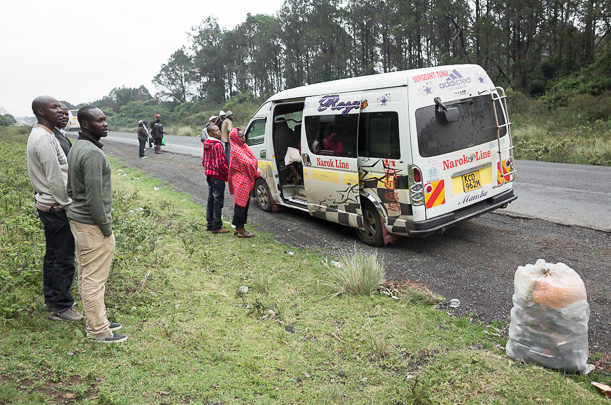
Our broken-down matatu.
THE AFRICAN RIFT VALLEY
The ride from Nairobi to Narok passes the African Rift Valley from a high vantage point along the eastern side of the valley, and if you’re in a private car on the way to/from Maasai Mara, you stand a pretty good chance of stopping here for a vista and related photos. Not us – I saw the Rift Valley briefly through an extremely dirty bus window as I sat in an aisle seat, clutching my backpack so it wouldn’t fall onto other passengers. It’s fine though – the valley was pretty hazy and less photogenic than some people claim it is – it’s honestly just a huge, wide valley. Moving on.
THE REST OF THE RIDE
This was pretty uneventful, honestly. Just another ride in a somewhat dirty old bus. A number of locals that seemed kind of amused that I was there with them, including young kids that stared at me in a certain wonderment, like “what is this weird white dude doing here?” Pretty standard stuff.
ARRIVAL IN NAROK
We arrived in Narok just after 11:00 AM and I grabbed lunch at Narok Coffee House, which is a well-presented cafe and recommended spot to have lunch or breakfast when you pass through Narok. You can find it a short walk from where the bus drops you in Narok.
Step 2 of 2: Change Buses in Narok towards Sekenani Gate of Maasai Mara
There’s no direct public transport that’ll take you all the way from Nairobi to the Maasai Mara, so you’ll need to change matatus/buses in Narok to continue on your way.
Buses from Nairobi drop you at the top of a hill, just above what appears to be the center of Narok. You’ll need to either walk down the hill or hire a motorbike (known as “piki piki” or “boda boda”) or taxi to take you to your destination. All and all, it’s about 1.5 km total.
I walked, which took about 15 minutes, and works like this:
- After disembarking from your transport from Nairobi, face the main road (north) and turn RIGHT (east) to walk down the hill into town.
- After walking about 10 minutes, you’ll cross a bridge over a small river. At this point you’re “in town”. Continue to walk about 200m and look for a petrol station on the left side of the road.
Turn LEFT at this petrol station, and continue towards the Naivas supermarket (look for signs). Walk about 300m more and you should see the Naivas on your LEFT. The bus “station”, which is just a busy, dusty open air lot will be on the opposite side of the road – you should see a mosque with a minaret topped in green – walk toward it about 100m and you’ll be in the center of the bus lot.
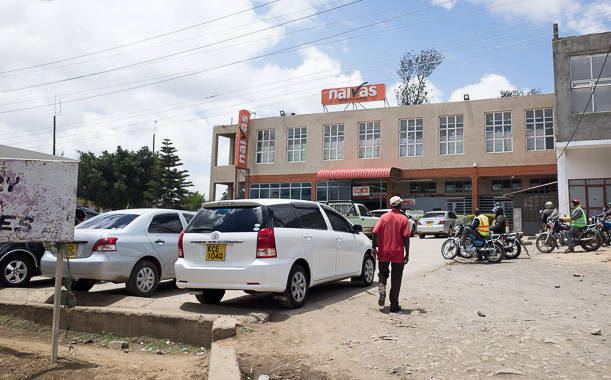
What you’ll see on your left: Naivas Supermarket.
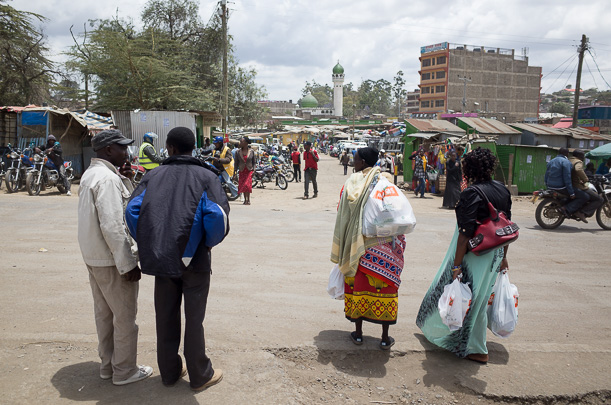
On you right: the entrance to the bus lot.
The ride from Narok toward the Sekenani gate of Maasai Mara will occur in either a jam-packed matatu or a jam-packed shared car. Either way, it should cost 500 Kenyan shillings one-way (note: my driver attempted to charge me double because of my backpack. This is a scam, don’t pay it!). And again, you don’t need to tip the bus driver or bus captain – it’s not expected (though they might ask anyway).
Also: make sure to tell your driver where you’re staying before you leave Narok, so they know where to drop you.
The trip will start on decent paved roads, but you’ll be spent the majority of the ride on unpaved, ungraded nastiness. My driver veered on and off the actual “road” for dirt tracks through scrub that proved a bit less bouncy than the road itself, and drove on the shoulder which often angled off at 30º or more. No, this is not a relaxing ride, but it’s also not worth complaining about. You’ve come this far, right?
You’ll see Maasai tribe villages dotting the road. Look for thin, athletic looking people wearing draped clothing often made of red plaid fabrics herding livestock, as well as livestock enclosures made of tall, closely placed sticks (to keep lions out!). There also seems to be a huge problem with plastic trash on the ground around said villages – look for wide and unfortunate village perimeters of discarded plastic bags and plastic bottles.
I arrived at Mara Explorers at 4:30 PM and the sun went down about an hour and a half later. Given the conditions of the roads and vehicles hired, this route could have easily taken less or more time though – just expect a full day of travel one way or another and you won’t be disappointed.
The return trip to Nairobi:
This should work pretty much the same way, and at the same cost. The only thing you’ll need to do ahead of time is arrange for a matatu or shared taxi to pick you up at your Maasai Mara lodgings to embark, as there really isn’t a bus station you can get to near Sekenani Gate. Talk to your lodge/camp the night before you leave in order to arrange this.
Are there good reasons to hire private transport instead of taking public buses?
Yes, certainly. If you’re a group of four people (for example), you can generally hire a car and split the cost of the vehicle four ways – meaning each of you would pay around US $25 each for the day’s transport (US $100 divided by four). This’ll be much more comfortable than riding matatu, and will take less time than having to deal with changing in Narok and waiting for matatus to fill up before they leave.
If I were in a group of four, this is probably what I would do. But if you’re traveling solo like I often am, public transport is still a considerably more economical option.
Thanks for reading!


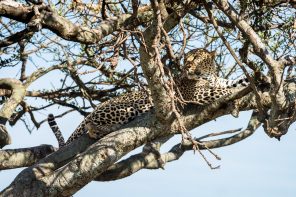
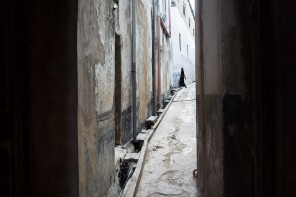
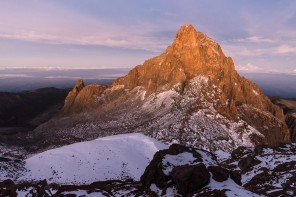
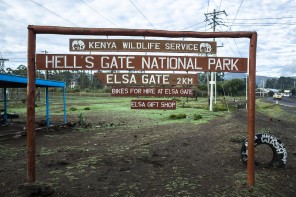
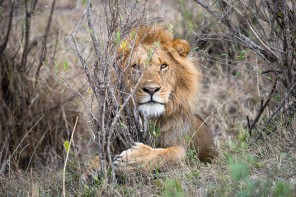
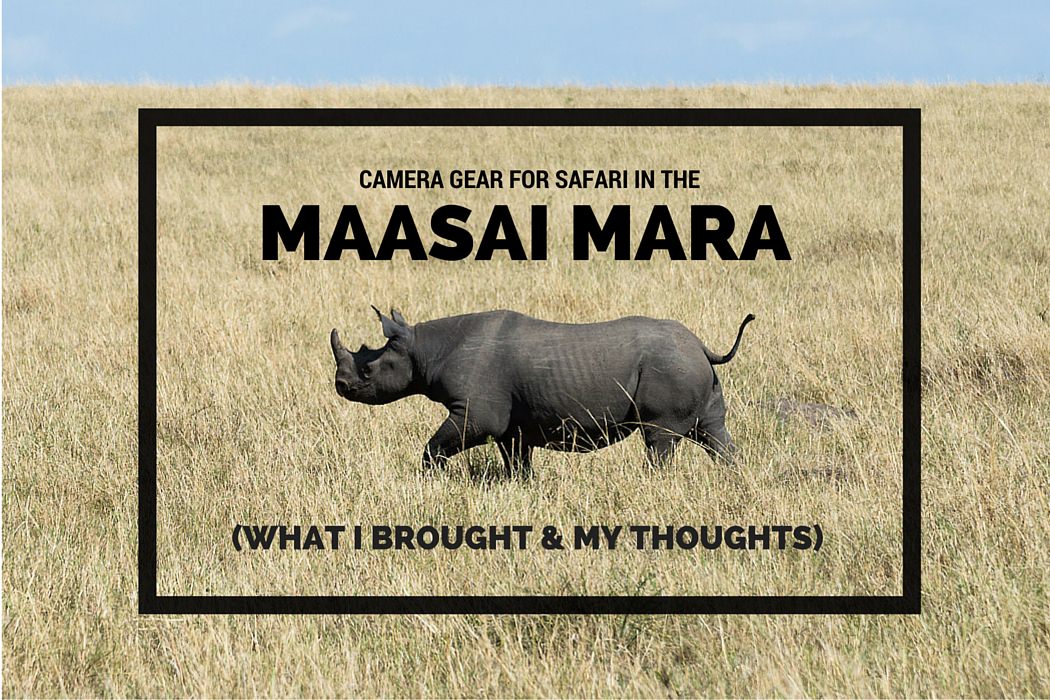
Wow! I enjoyed reading even lost my sleep that was so nagging my face. Am from Nairobi Kenya and I feel like explaining some situation, but I have nothing to add or omit from this description so close to awesome if not perfect. This is amazing keep up the good work!
Increíble read! Thank you
Thanks for sharing this
Thanks Matt. Great tips applicable even for me as a Kenyan …
Thank you, helpful read
Quite welcome! Thanks for dropping by the site!
this is extremely good… thanks for writing this
Thanks Juan! I figure little procedural posts like these can be very helpful to independent budget travelers.